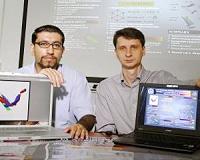 |
Washington DC (SPX) Nov 24, 2010 Airplanes do not look much like birds - unless you were to imagine a really weird bird or a very strange plane - but should they? This question is exactly what a pair of engineers in California and South Africa inadvertently answered recently when they set about re-thinking the ubiquitous tube-and-wings aircraft architecture from scratch in order to make airplanes more fuel efficient. The modern airplane design works well, but from a fuel efficiency standpoint, could planes be designed more aerodynamically - to lower drag and increase lift? Geoffrey Spedding, an engineer at the University of Southern California, and Joachim Huyssen at Northwest University in South Africa, felt they could in theory, but they lacked experimental evidence. Now they have it. Spedding and Huyssen have made a simple modular aircraft in three configurations: a flying wing alone, then wings plus body, and then wings plus body and a tail. It turns out that they had independently re-designed a bird shape, but without specific reference to anything bird-like. They presented their experimental data with these three designs, at the American Physical Society Division of Fluid Dynamics meeting in Long Beach, CA. They started with a configuration where the entire plane is one big wing. Then they added a body designed to minimize drag and, most critically, a small tail, which essentially serves to undo aerodynamic disturbances created by the body. Spedding and Huyssen analyzed the airflows and at various relative angles for the wings, body and tail, searching for ways to achieve greater lift (the better for carrying cargo) and lower drag (for higher fuel efficiency). They made the stipulation that for any given mission, the best plane is the one that generates the least drag. The flying wings alone provide an ideal (but impractical) baseline, since it's hard to carry people or cargo in such a shape. The presence of a body, unfortunately, immediately lowers the lift and increases the drag. The addition of just the right kind of tail, however, can restore the lift, and reduce the drag, occasionally to nearly wing-only levels. A few years ago a glider with the modest tail design was successfully test flown, but larger and commercial test prototypes have not yet been tried. Spedding recognizes that the design of real planes is necessarily a compromise of many engineering, economic and psychological constraints. Nevertheless, he believes much can be done to make planes more energy efficient in the future. "The most important point is that we may be wasting large amounts of fossil fuel by flying in fundamentally sub-optimal aircraft designs," says Spedding. "At the very least, we can show that there exists an alternative design that is aerodynamically superior. One may argue that there is now an imperative to further explore this (and perhaps other) designs that could make a significant difference to our global energy consumption patterns."
Share This Article With Planet Earth
Related Links American Institute of Physics Aerospace News at SpaceMart.com
 Simple Oscillating Flexible Wings Viable For MAVs
Simple Oscillating Flexible Wings Viable For MAVsWashington DC (SPX) Nov 24, 2010 In the future, tiny air vehicles may be able to fly through cracks in concrete to search for earthquake victims, explore a contaminated building or conduct surveillance missions for the military. But today, designing the best flying mechanism for these miniature aerial machines is still a challenging task. Creating micro-scale air vehicles that mimic the flapping of winged insects or birds ... read more |
|
| The content herein, unless otherwise known to be public domain, are Copyright 1995-2010 - SpaceDaily. AFP and UPI Wire Stories are copyright Agence France-Presse and United Press International. ESA Portal Reports are copyright European Space Agency. All NASA sourced material is public domain. Additional copyrights may apply in whole or part to other bona fide parties. Advertising does not imply endorsement,agreement or approval of any opinions, statements or information provided by SpaceDaily on any Web page published or hosted by SpaceDaily. Privacy Statement |